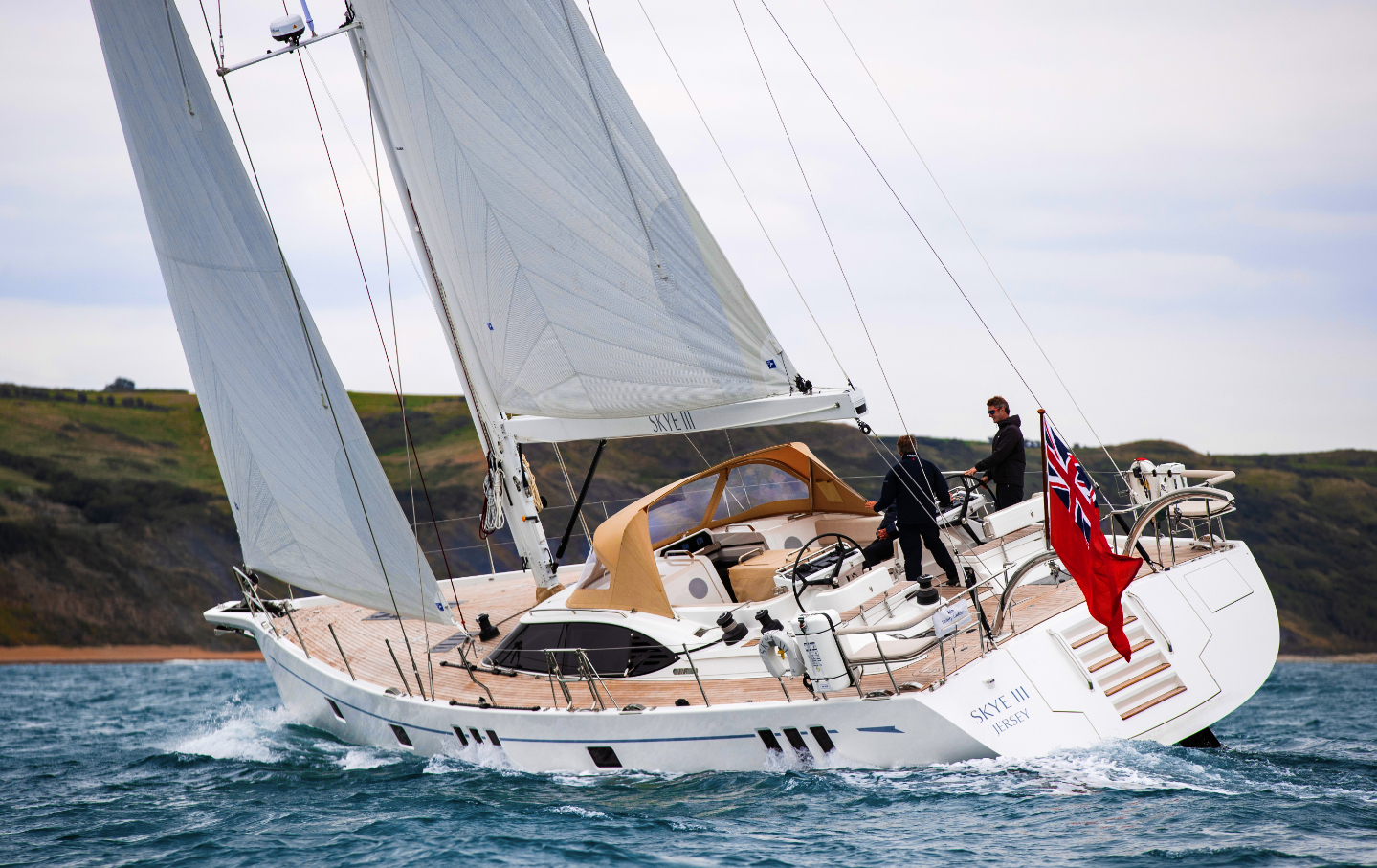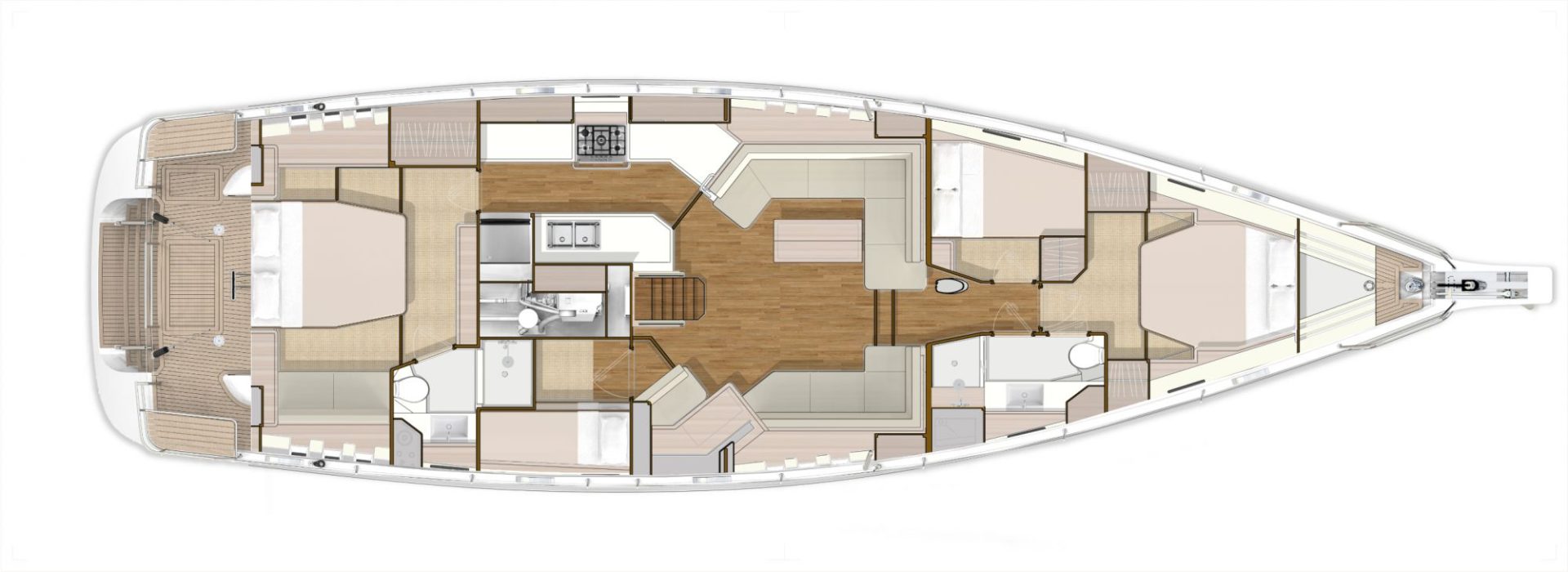Dream treatment
Oyster’s new 595 has already proven a sales hit, which is hardly surprising – it captures the very essence of a bluewater sailing pearl.
Written by Charlotte Thomas
05 April 2022
As a rule, pulling up the floorboards might not seem an obvious highlight when exploring an AU$5-million, 60-foot sailing yacht but, as a rule, you’re probably not on an Oyster. I am, and a highlight it is.
What we’re looking at is not so much double seawater inlets, easily accessible filters, industrial-strength pipework or a deep sump for dry bilges, but rather four decades of bluewater sailing yacht experience enhanced with the renewed energy of a resurgent boatbuilding icon.
Oyster COO Paul Adamson typifies this new lease on life for the brand. Adamson is a professional captain, who spent the early part of his career running an Oyster 56 and landed on Eddie Jordan’s 885 Lush in time for its launch and subsequent Oyster World Rally. Adamson’s enthusiasm is infectious.
It makes you feel Oyster really is back on track – and it’s reflected in the figures, too. The 595 sold 16 hulls before the first one even hit the water. Having sailed that first 595 on a calm and balmy September afternoon, I suspect there will be 16 very happy owners in due course.
“Many people ask me what I do, what Oyster does,” smiles Adamson. “I always say we create dreams, but we happen to build boats,” he says, which takes us straight back to that bilge. A yacht can quickly turn from dream to nightmare when things are badly put together or not accessible.
“It’s all thought out,” Adamson enthuses. “These are not only beautiful, luxury, go-anywhere yachts, they are also practical.”
“We haven’t lost that feel that this is a yacht that’s going to go to sea, which we need to be able to look after and maintain properly.”
All hulls are now built to Lloyd’s Register, which is evident in the monolithic carbon L-frame structure of the hull. The 595 is also the first Oyster to feature Oyster Command – full digital switching, controllable through a custom app. (See Ocean issue #98 for more on the digital switching system.)
It all adds up to an impressive package, and as we motor out into the Solent on the UK’s south coast, the first thing that’s apparent is just how quiet this yacht is. As we stand down below discussing various design aspects, conversation is easy above the drone of the donk.
To illustrate how well insulated it is, Adamson opens the starboard side access to the engine bay and the difference is startling.
The 595 will cruise quite happily at 9 knots under power, and at 7 knots it burns barely 2 litres of diesel per hour.
Furthermore, this Oyster has been conceived as the largest that can be comfortably handled by a couple, and for marina manoeuvres, this is borne out by the retractable bow and stern thrusters that come as part of the standard spec.
She’s pretty nimble anyway and turns on her keel – there’s an option for a centreboard keel if you need a shallower draft of just 1.66 metres, and that version may feel further benefit from the thrusters in a crosswind.
Our test boat featured an upgrade to lithium-ion batteries, which can be kept topped up thanks to the 11 kW Onan genset and a hydrogenator, which sits on a fixed saildrive leg between the keel and the twin rudders.
It easily grabs 20 W or more for nothing as we sail along, and although it isn’t retractable, it can be put into freewheel mode if you think it’s costing you boatspeed.
That said, this is a bluewater cruiser, not a regatta queen. Although a standard mast with fully battened big roach main and Park Avenue boom is available as an option, as Adamson says, “None of the 16 boats sold so far have it!”
What they have all chosen is a Selden rig with an in-mast hydraulic furling vertical-batten main, which is easy to control from the cockpit, coupled with a 105-percent hydraulic furling headsail. The headsail sheets are run aft via inner-deck tracks to reduce deck trip hazards and eliminate flailing yankee sheets.
The main also gets simplified, with the omission of a traveller. “You just don’t use them on a bluewater boat; you vang sheet a boat like this,” Adamson offers.
“We’ve taken away a lot of the toe-stubbing equipment and that’s definitely a big change. If you jumped off this and onto a 625 or a 575, you’d notice how cluttered that deck is. All of that is gone – we’ve gone for really flush decks and tried to simplify the boat.”
This is evident in the rig plan too, which features swept-back spreaders and chainplates that are moulded into the topsides. This ensures greater strength, takes out a point that could leak and creates a wide shroud base, which in turn makes it easy to walk forward.
And, once up on the foredeck, the wide-open space is a joy. Oyster has managed to omit the pickle fork that typically creates headroom below decks by adding in the most subtle of reverse sheers, which means this area can be used as a delightful leisure zone at anchor thanks to clip-on sun pads.
Even under way, things have been kept simple – there are no halyard tails hanging from the mast, and if you want additional downwind grunt, you can either tack an asymmetric to the stem head or opt for a dedicated Code Zero, which again can be controlled from the cockpit.
None of this has meant a compromise in sailing performance. While the Solent didn’t offer 40 knots of wind to test heavy airs capabilities, the bluewater credentials of Oysters are well established.
Light airs can be tricky, however. And, as I well know from experience, there is nothing more morale-sapping than being stuck in the middle of the ocean adrift in the zephyrs with three lemons on the log – zero speed!
The Solent teases us with 11 to 12 knots true then, on flat water with headsail and full main, she quickly climbs to 8.3 knots through the water at 90 degrees true wind angle (TWA).
Soon, the breeze fades, but the 595 is not fazed – 6.9 knots boat speed at 70 degrees TWA and 7 knots true wind speed (TWS); 6.5 to 7 knots boat speed at a TWA of 40 to 60 degrees and 6 knots TWS; and finally, 5.3 knots boat speed at 75 degrees true as the wind dies to 4.5 knots and finally disappears.
What’s more, even in those light airs, the steering not only remains responsive but also retains feel, meaning you stay engaged with the experience. Perhaps this beast could be a regatta queen, after all.
Sitting at anchor, we get to enjoy the other side of the 595. The guest cockpit is large, and the folding table will easily cater to alfresco dinners with family and friends. The cockpit feels very secure, helped in part by the twin helm area being separated from it.
That’s not to say the cockpit is cut off – a walkway between the helms leads to the aft deck, the twin transom corner seats, and the sea off the back.
“We say you should almost be able to get your swimming costume on then run in a straight line to dive off the back of the boat,” Adamson enthuses. “That’s pretty much what we’ve got on the 595.”
The standard transom is fixed, but the hydraulic option, which drops to create a swim platform, is worth considering as it also makes boarding the tender easier.
Another tempting option is the hydraulic passerelle that sits in a cassette to starboard in the transom. This makes getting on and off the boat a breeze.
Bluewater cruisers will also appreciate the extensive stowage aboard, from the large lazarette to the giant foredeck sail locker behind the chain locker. The anchor system itself uses a Lewmar powered windlass, and the 595 comes with 130 metres of stainless chain.
There’s also a vented locker aft, a throwback to carrying gas bottles (the 595 is a gas-free boat), which is perfect for carrying petrol for the tender’s outboard. The tender itself is carried aft on davits.
Our test boat had a full-beam master aft with a second double cabin in the bows and an additional twin bunk cabin forward to port, although usually this would be a cosy double.
There’s an option to have the master forward and then two guest doubles in the aft end, for which the third cabin forward becomes a large seating area in the master, but so far no-one has opted for that layout.
There’s also an additional bunk cabin to starboard aft of the chart table, which could be used as a crew cabin or a workshop.
The master gets two sets of seascape windows and the cabin has plenty of headroom, ensuite, big robes and a feeling of space. The 595 also features a multi-mode lighting system with preset moods.
The galley runs up the port side from the master and into the saloon, wide enough for two to pass but narrow enough to give good bracing at sea.
Standard equipment is high-spec, and options for a washer-dryer, dishwasher and other elements mean the 595 will be great for long-term cruising. There’s an induction cooktop, and an option for a Quooker tap for instant boiling water.
The saloon is spacious, and opening front windows allow for plenty of air when moored. Running below the coachroof windows to the sides is a rail that offers both a handhold and conceals recessed lighting and the air-con vents. The popular finish du jour is oak, but Oyster offers a variety of woods to suit.
It’s easy to get lost in the details on the 595, and it’s true that this level of quality comes at a price – close to AU$5 million, or more when you start adding in some of the desirable options – but this is a yacht you could keep for life and it would still have life left in it.
It is, as Adamson implies, not just a boat – it’s a dream.
















